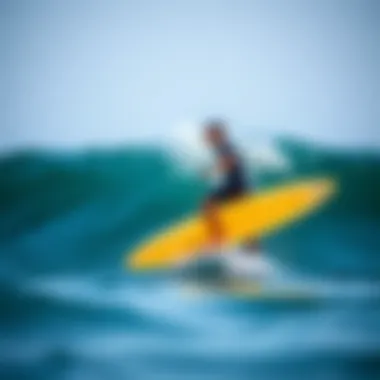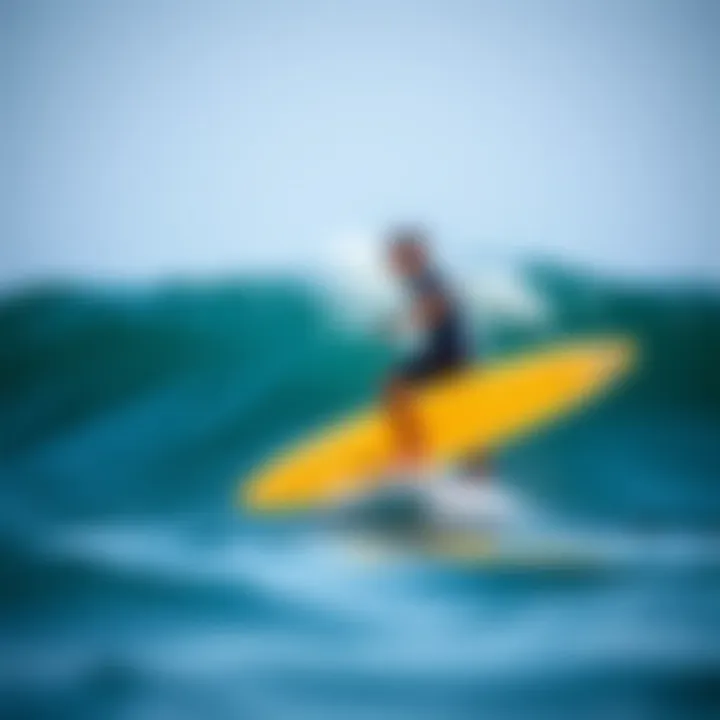Selecting the Right Longboard: A Comprehensive Guide


Intro
Choosing the right longboard can be a game changer in the world of skateboarding. Whether you’re a newbie just looking to roll around the block or a seasoned skater aiming to carve some serious turns down the hill, understanding the nuances of longboards is essential. This guide is tailored to equip you with the knowledge needed to make an informed decision, ensuring your ride aligns with your style, skill level, and the terrain you'll tackle.
Longboards come in various shapes and sizes, each serving different purposes. From cruising on flat pavements to tackling steep downhill sessions, the type of longboard you select can either enhance your experience or pose challenges you might not anticipate. Factors such as deck material, wheel size, and truck design can drastically influence how your board behaves under various conditions.
This article breaks down the key components that make up a longboard and delves into different types of setups that cater to various rider preferences. Being informed about the essentials allows you not only to select the right board but also to refine your riding skills along the way. So, let’s get rolling into the nitty-gritty of longboard selections.
Gear and Equipment
When diving into the world of longboarding, the selection of gear and equipment stands as a fundamental pillar. The nuances of each component significantly affect how the board performs. Here, we discuss the latest longboard technologies and essential accessories that can enhance your riding experience.
Latest Longboard Technologies
The tech behind longboards has evolved over the years, emphasizing improved performance, safety, and rider comfort. Currently, some notable advancements include:
- Flexible Deck Materials: Boards are now often made from a combination of bamboo, fiberglass, and carbon fiber. This mix offers a balance between flexibility and durability, providing a smoother ride.
- Drop-Through Deck Designs: This design allows for a lower center of gravity, making it easier for riders to push off and maintain stability at higher speeds.
- Advanced Wheel Formulas: Modern wheels come with different durometer levels and shapes, giving riders multiple options based on their riding preferences—harder wheels provide speed, while softer wheels offer grip and comfort.
These advancements contribute to more enjoyable longboarding experiences, so knowing about them can help in making a better purchase.
Essential Accessories for Every Longboarder
While choosing the board is crucial, accessorizing properly can enhance safety and comfort. Here are some accessories every longboard rider should consider:
- Helmet: A well-fitted helmet is an absolute must, no two ways about it.
- Protective Gear: Knee and elbow pads can save you from injuries, especially when learning new tricks.
- DIY Maintenance Kits: Keeping your board in good shape ensures longevity. Basic tools for tightening screws, changing wheels, and adjusting trucks are vital for maintenance.
Investing in the right gear and understanding the latest technologies not only fine-tunes your riding experience but also keeps you safe as you explore new terrains and styles.
"Safety first, style second; there's no joy in riding if you end up injured."
By paying attention to these factors, you’ll have the foundation to select a longboard that serves your specific needs, paving the way for a thrilling longboarding journey.
Surf Techniques and Skills
The journey of longboarding doesn’t end at choosing the perfect board. Developing the right techniques and skills is essential to mastering the art of riding.
Beginner Longboarding Techniques
For those stepping onto a longboard for the first time, here’s a brief rundown of foundational skills:
- Pushing Off: Start with one foot on the board. Use your other foot to push off the ground, gaining momentum before stepping onto the board.
- Balancing: Focus on your body position. Keep your knees slightly bent and evenly distribute your weight.
- Turning: Lean into turns by shifting your weight accordingly; practice gentle curves before attempting sharp turns.
Mastering these basics can empower you to gain confidence on the board.
Advanced Maneuvers for Experienced Riders
Once you've nailed the basics, you might want to elevate your skills. Here are some techniques to explore:
- Carving: This involves shifting your weight back and forth, allowing for smooth, controlled turns and maintaining speed.
- Sliding: A more advanced technique that involves making your board skid sideways, which can be useful for navigating sharp corners or slowing down quickly.
- Downhill Riding: As you progress, tackling downhill runs can be exhilarating. Just remember, control is key.
Acquiring these skills not only amplifies your riding experience but also opens up new realms of fun and adventure near to what a surfer feels in the waves.
The road to longboarding mastery is paved with practice and patience, and understanding your board’s equipment is just as crucial as honing your skills. With the right gear and techniques, every ride can be a thrilling experience.
Prelude to Longboarding
Longboarding serves as a delightful blend of sport and transport. Understanding its foundational aspects opens new avenues for enjoyment and experience. As riders, many find themselves unsure of where to start, leading to feelings of overwhelm. That's where this guide comes in—not just to help you choose the right board, but to appreciate the nuanced world of longboarding.
Defining Longboarding
At its core, longboarding is distinct from traditional skateboarding. While skateboards are typically shorter, longboards can stretch anywhere from 33 to 60 inches or more in length. Their size and design lead to various riding experiences, enabling riders to glide over pavement like a breeze. This form of skating often puts greater emphasis on cruising and carving, attracting different enthusiasts. It's more than just a mode of transport; it's about embracing freedom while rolling past scenery, feeling the wind whip your hair.
It’s important to grasp that longboarding isn’t solely about tricks or speed. People engage with longboarding for leisure, commuting, or simply sharing a moment with friends. Each ride can evoke a sense of community and joy, regardless of skill level.
The Evolution of Longboards
Longboards have gone through a significant transformation. Initially emerging in the 1950s as a tool for surfers seeking to replicate wave riding on dry land, longboarding has since evolved. The designs in those early days were rudimentary, more akin to oversized skateboards with crude wheels. However, as popularity increased, so did innovation. Today's longboards feature advanced materials such as bamboo and fiberglass, allowing for better flexibility and lighter weights.
A notable turning point happened in the 1990s, coinciding with the rise of downhill racing. The board shapes and wheel designs adapted to meet the demands of speed aficionados. Now, longboards cater to diverse styles—from freestyle and cruising to downhill and freeriding—giving riders multiple options based on preference.
Why Choose a Longboard Over Other Boards
When it comes down to it, one might ponder what sets longboards apart. Choosing a longboard over other types of boards, like traditional skateboards or even scooters, offers advantages that resonate with various riders. For instance, longboards provide stability due to their lower center of gravity and longer wheelbase, which is especially appealing to beginners. This quality makes initiating turns and carving much more forgiving than on a regular skateboard.


Moreover, the comfort of riding a longboard over long distances is a bonus. Many longboard enthusiasts gravitate toward it for commuting. It's an eco-friendly alternative to cars, not to mention the fun factor inherent in riding over a smooth surface.
In summary, longboarding presents a unique mix of community, technological advancement, and engaging experience. Whether your goal is slick cruising, effective commuting, or just hanging out with friends, understanding the basics is key to selecting your ideal board.
Understanding Longboard Components
Understanding the components of a longboard is crucial for making an informed decision that truly fits your needs and ambitions as a rider. Each part contributes to the performance and experience, whether you’re commuting through city streets or carving down mountain trails. Selecting the right components can heavily influence your ride’s stability, control, and overall enjoyment.
Types of Decks
The deck is essentially the foundation of your longboard. The type, material, and dimensions of the deck play a pivotal role in defining how your ride feels and performs.
Drop-through vs. Top-mount
When it comes to deck mounting styles, drop-through and top-mount are often debated among enthusiasts. Drop-through decks have cutouts where the trucks sit, allowing the board to sit lower to the ground. This low-profile design enhances stability, making it a popular choice for downhill or freeriding styles. Conversely, top-mount decks place the trucks directly on the bottom of the deck, achieving a higher ride height. While this offers greater leverage in turns, it can compromise stability at speed. The beneficial aspect of drop-through decks is their low center of gravity, providing better balance, while top-mounts are favored for their responsiveness.
Material Considerations
Material is another significant factor in decks. Most longboards are made from wood, such as maple or bamboo, but options also include fiberglass or composite materials. Bamboo decks are lighter and offer good flex, making them a great choice for cruising. Maple decks provide sturdiness but can be heavier and less flexible. When you choose a deck, think about how weight and durability affect your riding experience. A heavier board can be less maneuverable, impacting tricks or sharp turns.
Length and Width Specifications
Ultimately, length and width dictate both the ride comfort and handling. Longer boards are generally better for stability and cruising, while shorter boards are easier to maneuver. A wider deck allows for a more stable stance, which is important for newer riders or those planning on tackling rougher terrain. However, a narrow board can facilitate an agile ride ideal for tricks and tight turns. Consider your body size and preferred riding style when determining dimensions to ensure a comfortable fit.
Choosing the Right Trucks
Trucks are the metal components that attach the wheels to the board and offer pivotal control and turning capability. Selecting the appropriate trucks is fundamental since they directly influence the way your longboard handles.
Truck Width Considerations
The truck width should be proportionate to the width of your deck. A truck that is too wide can lead to instability, while one that is too narrow can affect turning ability. The most common flexibility is to use trucks that are roughly the same width as the deck. For instance, 149mm trucks work well with decks in the 9-10 inch range. This consideration helps in maintaining balance and stability across various riding styles.
Types of Trucks: Traditional vs. Reverse Kingpin
Traditional trucks are typically used for street skating while reverse kingpin trucks are favored in longboarding. The kingpin design impacts the ride experience significantly. Reverse trucks are shaped to provide better leverage for turning, making them ideal for carve-heavy riding or downhill runs. This contributes to a smoother ride but can be less responsive than traditional setups under specific conditions.
Adjustability and Performance
The ability to adjust your truck’s tightness is vital for performance tuning. Many longboarders prefer adjustable trucks that can be fine-tuned for comouflage in a range of riding styles. Tightening the trucks allows for less wobble at high speeds, while loosening them can provide more maneuverability at lower speeds. This the key to customizing your board experience.
Wheel Selection and Impact
Wheels are what connect you to the ground and contribute massively to the dynamics of your ride. The right wheels ensure adequate grip, speed, and comfort on various surfaces.
Durometer and Hardness Levels
Wheels are rated on a durometer scale, indicating their hardness. Softer wheels (78A-87A) offer better grip and can absorb bumps, making them excellent for rough terrains or cruising. Conversely, harder wheels (88A-101A) translate to speed and slide capability, suited to slick surfaces and downhill racing. These options reflect your personal preferences and riding environments.
Size Matters: Diameter and Profile
Wheel diameter significantly affects how a board handles. Larger wheels (over 70mm) roll over cracks and bumps more smoothly while providing additional speed. Smaller wheels (under 70mm) allow for easier tricks and tighter turns but can get hung up on imperfections in the road.
Wheel Shapes and Their Effects
Not all wheels are created equal in shape. Generally, you have square-edged wheels providing better grip and ride stability at high velocities, while round-edged wheels are designed for easier slides and tricks. The shape of the wheel will define how well the longboard performs in certain styles, from cruising to downhill racing.
Selecting an appropriate deck, trucks, and wheels ensures riders optimize their longboard for performance, comfort, and style.
Identifying Your Riding Style
Understanding your riding style is essential when it comes to selecting the right longboard. Your approach to riding will significantly influence the type of board that will best suit your needs. Each riding style has distinct characteristics, and recognizing these can lead to a more enjoyable and effective riding experience. It’s like finding the right shoe for a specific activity—running shoes feel wrong on a basketball court, just as certain longboards won’t feel right for every riding scenario.
Knowing your riding style not only impacts convenience and comfort, but also safety. A board that aligns with your preferred style enhances control and stability, especially in diverse terrains. As you read on, what follows are several prominent riding styles, along with insights to help you pinpoint which one resonates with you.
Cruising and Commuting
Cruising and commuting often go hand-in-hand, especially for those seeking an alternative means to navigate urban landscapes. This style involves riding at a moderate pace, often on flat, smooth surfaces. A thorough understanding of this style will enable you to connect with your longboard on a deeper level, where ease and efficiency reign supreme.
Key Points of Cruising and Commuting:
- Board Flexibility: Look for a longboard that offers enough flex to ensure a comfortable ride. A flexy board often absorbs vibrations from cracks and bumps in the pavement, making for a smoother journey.
- Wheels: Softer wheels (with a lower durometer rating) are typically preferred for cruising. They grip the pavement better, which can add to comfort on longer rides.
- Length: Longer boards can enhance stability, while shorter ones tend to be more maneuverable. A good midpoint is often a board around 38-42 inches.
Freestyle Riding
Freestyle riding embodies creativity and spontaneity, allowing riders to express themselves through tricks and stunts. This versatile style encourages experimentation, as riders can pull off maneuvers like shuv-its, 180s, and slides with suitable boards.


When considering freestyle riding, think about the following:
- Deck Shape: A symmetrical shape is typically best for freestyle. This lets you ride in either direction without losing performance.
- Lightweight Materials: A lighter board allows for easier lifts and flips. Many prefer using decks made from bamboo or maple to strike a good balance between weight and strength.
- Truck Setup: To execute tricks successfully, look for boards with trucks that allow for easier turns and tricks. A wider truck base helps maintain balance when performing spins.
Downhill Riding Techniques
For thrill-seekers, downhill riding offers adrenaline-pumping speeds and a test of skill. It’s crucial to grasp the fundamentals here, as it’s not just about speed; it's also about control, stability, and technique when tackling steep inclines and rocky paths.
Techniques to master for downhill riding:
- Body Positioning: Lowering your center of gravity helps maintain balance. Bend your knees and lean forward for better control and aerodynamic posture.
- Brake Control: Know how to use your foot braking and slide techniques effectively. A good understanding of braking techniques is paramount; after all, speeding down a hill also requires stopping it safely.
- Board Characteristics: An ideal downhill board is typically low, with a rigid deck to provide stability. Wider trucks and harder wheels are also recommended to enhance grip and response during tight turns.
Freeriding Dynamics
Much like downhill riding, freeriding melds thrill with control but adds more complexity through drifting and sliding. This style focuses on controlled maneuvers that allow riders to transition between speed and tricks seamlessly.
Freeriding Essentials:
- Board Features: Opt for boards with a functional design for slides—this includes a wider tail for stability and a symmetrical design that promotes easy switch riding.
- Wheels: Consider wheels designed for drifting; they are usually harder and provide less grip, making slides easier.
- Foot Placement: Strategically position your feet for optimal control—lead foot near the front and rear foot providing pressure to initiate a slide can make all the difference.
Skill Levels and Board Selection
Choosing the right longboard goes beyond just aesthetics or brand recognition. Skill levels play a vital role in determining the ideal board for a rider's unique experience. Different skill levels come with diverse needs and expectations. Understanding these distinctions can help new riders avoid costly mistakes while enhancing their enjoyment and safety on the board. A well-chosen longboard caters to the rider's abilities, ensuring they can progress their skills without unnecessary frustration.
Beginners: Essential Attributes
For those just starting, selecting a longboard requires careful consideration of specific attributes. Beginners typically benefit from boards that provide stability and ease of use. Look for the following features:
- Wider decks: A broader platform helps maintain balance, which is crucial for new riders.
- Lower ride height: Boards with a lower center of gravity tend to provide a more stable feeling. This can help in building confidence on the board.
- Soft wheels: Softer wheels absorb shock better, minimizing the impact of bumps and cracks in the pavement.
These essential attributes can significantly ease the learning curve. It's often advisable for beginners to start with a completer longboard that is pre-assembled, ensuring that all the components work well together without any guesswork.
"A solid foundation makes all the difference when learning to ride."
Intermediate Riders: Skill Enhancement
Moving beyond the basics, intermediate riders often seek to refine their skills and explore new riding styles. At this stage, longboards should offer features that enable more freedom to maneuver and experiment:
- Moderate flex: Boards with a little flex allow for better carving and responsiveness, enabling riders to connect with the board.
- Quality trucks: Intermediate riders should look for sturdy trucks that can withstand more aggressive riding techniques.
- Wheel hardness: Opting for a balanced hardness level will enhance performance when handling different terrains.
This phase is about finding the board that complements one’s growing skills while allowing for mistakes. Intermediate riders can benefit from experimenting with various styles like downhill or cruising, which offers ample opportunity for improvement.
Advanced Riding: Performance Needs
Advanced riders have distinct needs that demand precision and performance from their longboards. At this level, every aspect of the board should align with the rider's specific preferences and riding conditions:
- Customizable setups: Advanced riders often choose to personalize their trucks and wheels for optimal tuning.
- Rigid decks: A stiffer deck can provide a more responsive ride, particularly in high-speed downhill scenarios.
- Specific wheel profiles: Tailoring the wheel shape and hardness for various surfaces maximizes traction and minimizes drag.
At this point, the focus shifts from just fun to performance maximization. It’s not uncommon for advanced riders to select boards tailored for specific activities, such as cruising or tricks, to enhance their skills further.
Ultimately, understanding skill levels when choosing a longboard ensures that riders can select a board that complements their journey. Whether one is just getting their feet wet or carving down steep hills, the right longboard can serve as a supportive partner through every twist and turn in the learning curve.
Longboard Brands and Purchasing Considerations
When it comes to longboarding, the brand you choose can greatly influence your experience on the board. In this section, we’ll explore the significance of selecting the right longboard brand and what you should consider before making a purchase.
First off, brand reputation plays a huge role. Well-established brands like Sector 9, Santa Cruz, and Land Yachtz have a proven track record of producing durable, reliable boards that can withstand a range of terrains and riding styles. Newer brands may offer colorful options or unique designs, but often lack the performance or quality assurance that comes from years of engineering and design refinement.
Another crucial point is warranty and customer service. Quality brands typically stand behind their products with decent warranty protections. If something goes wrong with your board, a responsive customer service team can be the difference between a smooth resolution and a frustrating experience.
So, keep in mind that choosing a reputable brand isn’t just about aesthetics; it’s about ensuring that you’re investing in a long-lasting product.
Established Longboard Brands Worth Considering
There’s no shortage of brands out there, but some truly stand out in the longboarding scene. Here’s a short list of established brands with solid reputations:
- Loaded: Known for their flexible decks and innovative designs, they’re favored among serious longboarders.
- Santa Cruz: Offers a mix of artful graphics and solid performance, making them a great choice for those who want a mix of style and substance.
- Bustin Boards: This brand focuses on quality craftsmanship and offers a wide variety of longboard styles, from cruisers to downhill racers.
Ultimately, the choice boils down to personal preference, but leaning towards established brands often provides peace of mind.
Quality vs. Price: Finding the Balance
In the world of longboarding, price can be a tricky proposition. You might be drawn in by a budget-friendly option, but often, you get what you pay for. Cheap boards from obscure brands may seem alluring, but they might not stand the test of time. The components used in cheaper boards can make them less durable or even unsafe.
However, it’s unnecessary to break the bank to buy a quality longboard either. Brands like Penny and Rayne offer excellent boards at reasonable prices, ensuring you don’t compromise on safety and performance.


Key Considerations When Balancing Quality and Price:
- Material Quality: Boards made from high-quality maple or bamboo tend to last longer.
- Component Durability: Check reviews focusing on trucks and wheels to ensure they won’t wear down quickly.
Buying a quality board is an investment, and sometimes a higher upfront cost can save you from pitfalls down the line.
Where to Buy: Online vs. Local Shops
In today's market, you have the option of purchasing your longboard online or from local shops, each with its benefits. Shopping online gives you access to broader selections and often better prices. Websites like Amazon, Zumo, and Tactics can provide competitive deals, and you may also find custom options.
On the other hand, local shops offer unique advantages. You can physically check out the board, feel its weight, and sometimes even test ride it. The staff can provide personalized advice based on your skill level and riding style, which can be invaluable to a novice.
"Purchasing locally might cost a bit more, but the hands-on experience can offer insights that online shopping simply cannot."
If you decide to shop online, ensure you read customer reviews and check return policies. If you can’t try before you buy, knowing you can send it back if it doesn’t feel right is essential.
Maintenance Tips for Longevity
Understanding how to maintain your longboard is paramount for not just prolonging its lifespan but also enhancing your overall riding experience. A well-kept longboard not only performs better, but can also significantly improve the safety and stability of your rides. Remember that like any piece of gear, longboards undergo wear over time, and knowing how to care for them is essential for anyone who wants to get the most out of their investment. Here we’ll explore regular maintenance routines, tips for identifying wear and tear, and guidance on when to upgrade replacement parts.
Regular Maintenance Routines
Keeping your longboard in top shape starts with establishing a consistent maintenance routine. This might sound tedious, but a few simple practices can extend the life of your board dramatically.
- Clean Your Board: After every few rides, take a moment to clean your board. Dirt and debris can scratch the deck and affect performance. Use a damp cloth to wipe down the wheels and a brush for the bearings.
- Check the Hardware: Periodically check all screws and bolts to ensure they are tight. Vibration from riding can loosen them over time. Use a skate tool to ensure everything is secure.
- Bearing Maintenance: Regularly oil and clean your bearings to keep them smooth and free of dirt. A few drops of bearing oil can work wonders. If you feel they are getting sluggish, they may require a deeper clean or replacement.
- Wheel Inspection: Look at your wheels for any uneven wear. If you notice flat spots or cracks, it’s time to consider replacement.
Moreover, it’s a good idea to rotate your wheels every few weeks. This helps distribute the wear evenly, allowing each wheel to have a longer lifespan.
Identifying Wear and Tear
Being able to recognize when your longboard is showing signs of wear can save you from larger issues down the road. Here are some common indicators:
- Deck Damage: Look for cracks, chips, or delaminations on your deck. If your board feels less stable, it might be time to replace it.
- Wheel Deformities: Signs of wear like flat spots, uneven profiles, or excessive softness in the wheels can affect your riding dynamics. If your wheels are no longer round, they're not doing their job.
- Loose Trucks: If your trucks feel wobbly or loose while riding, check the nuts and bolts, as well as the bushings. Worn bushings can lead to a lack of control.
- Bearing Grime: If you start to hear a grinding noise when the wheels spin, your bearings need immediate attention. Replacing bearings regularly is advisable to maintain performance.
Replacement Parts: When to Upgrade
The question of when to upgrade parts of your board can be tricky. Not every dent or scratch means a replacement is in order, but there are certain guidelines to follow.
- Worn Down Wheels: If you find that your wheels have become flat or misshapen after numerous rides, this is a clear signal to replace them. Performance declines as wheels age.
- Deck Degradation: A damaged or weak deck is a safety hazard, particularly for advanced riders who push their limits. If your board feels less sturdy, it’s time for a new deck.
- Bearing Failure: As mentioned previously, turbulent noise or sluggish performance from your bearings indicates they need to be replaced. Do not ignore signs of impending failure.
- Truck Issues: If the trucks no longer offer a stable ride despite tightening them, it may be time for new ones. Aging trucks can impact your balance and carving ability.
Taking a proactive approach to maintenance ensures your longboarding experience remains enjoyable and safe.
Remember, a little care goes a long way; treating your longboard with respect will pay dividends in performance and durability.
For more tips and community wisdom, dive into resources such as Reddit longboarding community and Wikipedia's skateboarding page. Stay informed and ride safe!
Final Considerations
When it comes to choosing the right longboard, several final considerations can greatly impact your experience. At this juncture, it’s crucial to distill the plethora of information previously discussed into practical steps. The decisions made now will shape your longboarding adventures from the ground up, giving you the chance to optimize your ride for your individual style and needs.
First and foremost, testing before purchasing a longboard can’t be overstated. Many local skateboard shops have demo boards—this enables you to take a few models for a spin. Feel how different decks, trucks, and wheels respond under your feet before making a financial commitment. A board that looks good on paper might not suit your style when you actually ride it.
Additionally, becoming a part of longboarding communities can yield invaluable advice not easily found in articles or reviews. Not only do these communities provide a wealth of resources, but they also foster camaraderie among riders. The experiences shared by fellow longboarders can shine a light on local spots, types of boards that excel in certain conditions, and even tips on maintenance and upgrades that can extend your board's lifespan.
Ultimately, the goal is to make a choice that enhances your riding experience—not just for now, but for the long haul. Considerations around budget, riding style, and personal preference should all coalesce into a clear picture that guides your purchase.
Testing Before Purchasing
Testing a longboard before you commit to the purchase is akin to trying on a pair of shoes before stepping out the door. You wouldn't buy footwear without seeing how it feels, right? The same principle applies here. The right longboard must feel intuitive underfoot, whether you're carving through busy streets or cruising along scenic paths.
When visiting a local skate shop, don't hesitate to ask if they have a designated area to demo boards. Pay attention to how the board responds to your movements. If you're leaning into a turn, is there stiffness or flex that suits your riding style?
Keep the following in mind during your test rides:
- Deck Shape and Size: Does it feel like an extension of your body, or do you feel awkward?
- Wheels: Test the smoothness on different surfaces. Try them on concrete, asphalt, and even gravel if available.
- Trucks: Notice their responsiveness; should they feel stable while turning?
These small tests can save you a ton of headache later. You’d be surprised how different decks can feel even if they share similar specs.
Longboarding Communities and Resources
Integrating yourself into longboarding communities can provide lasting value beyond just riding. Think of these hubs as treasure troves of information; whether online or offline, they can be instrumental in enhancing your longboarding knowledge.
For instance, Reddit hosts various longboarding subreddits where seasoned riders share reviews, tricks, and local meet-up spots. These platforms allow you to engage with like-minded enthusiasts who can offer perspectives that online retailers cannot.
Joining a local Facebook group focused on longboarding can also be beneficial. You can find individuals willing to share their favorite trails, gear swapping opportunities, or even local competitions.
Apart from social media, keep an eye out for local longboarding clubs or communities. Many towns have clubs where you can join group rides. Learning from experienced riders, getting tips, and practicing your skills in a supportive environment can be invaluable.
In summary, being part of a community enriches your longboarding experience. You get to learn new tricks, understand the nuances of board maintenance, and even discover new places to ride—all from the wisdom of those who share your passion.
Participating in community events and discussions can lead to unexpected opportunities and friendships that extend well beyond the world of longboarding.







